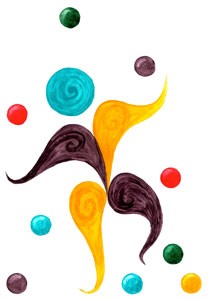This post was originally written during a time when many universities and workplaces had shifted to remote work in response to the COVID pandemic. Although circumstances have now changed for many people, much of what I say in this post still applies.
I’ve written before about juggling as a metaphor for planning out your workload.

Consider all of the things you want and need to do, at work and outside of work, as the box of things a juggler could be juggling.
- Identify your priorities so you are juggling fewer things.
- Use time blocking and policies to make sure that you get to all the important things.
- Only juggle one kind of thing at a time.
- Put down one thing safely before you pick up something else to juggle.
I’ve been using this metaphor in Planning Classes for members of the Academic Writing Studio for many years. It helps. As one of the Studio members said recently, she hasn’t finished the book that prompted her to join the Studio, but she’s written other things and she takes weekends off now. In other words, balls she used to drop, like writing and time away from work, are no longer being dropped. But what about that book?
Workload planning vs project planning
Helen Kara wrote something that helped me clarify the distinction between this kind of planning and planning a specific project. Workload planning, which is what I focus on in Planning Classes and the Monthly Review emails, involves fitting the things you need to do into the time available.
You also have project plans, which focus on what tasks you need to do in each area of your work to deliver the outputs you need to deliver — classes taught, meetings contributed to, data collected, papers written, etc. Those project plans also have a temporal dimension in that the tasks take time, and some of the projects have deadlines for delivering the output.
It occurred to me that, while juggling is a good metaphor for workload planning, project plans were more like jigsaw puzzles.

The tasks are like puzzle pieces you fit together.
- You might start out with what look like a random set of tasks, but you can group them together in ways that make it easier to put the whole puzzle together.
- You might find all the edge pieces to give it some shape.
- You might put one section together before moving on to the next one.
- You might move on to the next section even though there are a couple of pieces missing, knowing that those pieces will turn up later and you can come back to slot them in.
- You might focus on a recurring motif and find all those pieces first and then build the sections out from that basic framework.
This seemed helpful and yet when I went beyond that, the metaphor started to break. Badly.
I tried thinking about buying a jigsaw from a charity shop, or finding one in the cupboard at a cottage.
- You have no idea if all the pieces are there.
- You might have pieces from more than one puzzle and it takes a while to figure that out.
- Your puzzle pieces might be in the wrong box, or in a bag so you have no picture of the finished project.
That was sort of helpful but didn’t really solve the underlying problem.
The relationship between the pieces and the whole is helpful for understanding the difference between tasks and projects, and for thinking about grouping tasks in useful ways to break down a big project into smaller chunks.
But you are doomed as soon as you start thinking about your projects as having to look like the picture on the box, where you have to put together all the pieces in exactly the right way before you can call it finished. Most of your work isn’t like that.
From jigsaw puzzle to navigating by the stars
The process of working on your projects is more like an ancient mariner navigating by the stars.
Your vision for what this project could look like is the star. The star is not the destination. You are using the star to guide your journey. Just as the ancient mariners also had to account for shoals of fish, bad weather, and other things when they set their course, your journey from idea to output will also take other factors into account.

Unlike the jigsaw metaphor, the fact that what you deliver doesn’t look exactly like your vision does not mean there is something wrong with your vision, or that there is something wrong with you, or that there is something wrong with what you have produced.
The vision/star ensures that you go in the right direction, prioritize the right things, and make good decisions about what is not going to get done. It helps you identify the essential elements, without which the whole thing will not make sense, and the optional elements. It helps you decide between different optional elements. It helps you know when you’re in danger of doing too much, another way to risk the final output not making sense.
It’s not like a jigsaw puzzle, because there are many more options than finished or not-finished. Like a mariner you can vary your route when you take the journey again, using things you learned the last time to see if this new route is better. This might be particularly useful when teaching.
You might also find interesting destinations along the way. What you initially imagined as a single well-defined project, might turn out to be multiple small projects, or even something much bigger than you could imagine when you set out. Or, you might set out and discover part-way that this particular journey is not a good idea at all…
How abandoning the jigsaw metaphor helps you manage your workload
To match up the time it takes to create an outcome for your project, with the time available to do that work, you need some flexibility about what the outcome looks like.
- You need to know that what you deliver is good, even when you know that it could be better with more time or other resources.
- You need to know when the extra things you could do to it are not as valuable as the other things you could be doing with that time.
When you think of the outcome like a jigsaw puzzle, you have no flexibility.
You might assign a specified number of hours to work on it, because you have other important work to do and there are only so many hours in a day. If what you accomplish in that time doesn’t look like the picture on the box, you will be tempted to make yourself work on it longer. Other balls get dropped, or you have less time for other important projects.
Even with that extra time, you still might not get it to look like the picture on the box, which means either you are going to deliver something you feel bad about (e.g. you have to teach that class today and there is no more time to tweak your content) or you are going to not deliver things you need to deliver with ongoing consequences (e.g. you aren’t publishing and at some point that is going to cause a problem).
Using your vision as a guiding star creates motivation and momentum in the same way looking at the picture on the jigsaw box does. It also helps you make tough decisions about what is possible in the time available.
Because you are being guided by the vision, rather than treating it as a destination, you can use it to figure out what’s feasible.
You will have more realistic expectations of what you’ll achieve, and you’re more likely to meet or exceed those expectations.
Getting better at stopping at ‘good’, so you can also do good work on other things, means you can set firmer boundaries between different areas of your work, and between your work and the rest of your life. Doing a good job of this project doesn’t mean you’ve compromised something else.
This flexibility about what ‘finished’ actually looks like in practice, gives you more control over your workload.
- You can say yes to things with a clearer sense of how much time you are committing and what is feasible in that time.
- You can say no to things because you would not be satisfied with what you could do in the time you have available.
- You can be satisfied with what you delivered today, knowing that as you develop your knowledge and skills, what is feasible will change.
- You can imagine a 40 hour work week, even if it takes you a while to get good enough at the tough decisions to make it actually happen.
(Lots of) Related Posts:
Juggling 101: Elements of a Good Plan
You are not broken. You don’t need fixing.
Unpacking “busy”: the importance of being proactive instead of reactive
Academic citizenship & getting better at saying no
Prioritising meaningful work when you are feeling overwhelmed and powerless
Optimism in the face of uncertainty
This post was originally sent out in the mid-month newsletter on September 11 2020 and has been lightly edited since. Re-edited July 2025.







